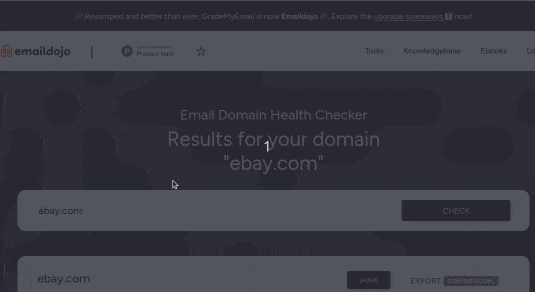Spamcop Blacklist
Published on 2020-05-05· Updated on 2023-09-06
Introduction
Spamcop is a SPAM reporting service that allows the SPAMCOP users to report the email sender's IP addresses that are sending them unsolicited emails. In the late years Spamcop became a part of Cisco Systems and now is marketed as a Cisco Service.
They provide a blacklisting service which is called SpamCop Black List (SCBL) that contains the list of blacklisted domains.
FAQ
- The SCBL
- SCBL Rules for IP Listing
- Removal from Spamcop Blacklist
- Automated removal
- Removal by request
The SCBL
SCBL is a list of blacklisted domains according to SpamCop. They work on user reporting. That means people using the SpamCop services report the domain IP they think are sending them unsolicited emails or spams.
It also means that if any SpamCop user lists your domain to the SpamCop, you will be blacklisted. The blacklisting would happen either way even if your intentions were not spamming.
Thankfully SpamCop removes your domain from the list after some time after being listed. The delisting is done if you are not repeatedly reported again into their blacklist. In the case a complaint is made after delisting, SpamCop increases the time frame for the next delisting of your domain.
For now, the domain listed by anyone lasts for 24 hours on the list. That means, even if you are registered, you can remove yourself automatically by avoiding sending emails to the reporting email address.
After someone raises a complaint, SpamCop parses the headers from the reported email and sends the complaint details to the reported address. To do this, Spamcop uses services like DNS, whois to check all the information about the email header.
The SCBL achieves the listing by comparing the number of complaint reports vs total amount of email sent from the domain to the reporting user.
Here are some of the definitions that SpamCop uses to define different kinds of email lists.
- Reported Email. These are the emails reported by SpamCop users. Spamcop reporting tool doesn't automatically determine whether the reported email is spam or not at the time of delisting. So it answers the email back to the sender.
- Spamtraps. The emails collected by the Spamcops by using their versions of spam traps. These are non-used email addresses used by the Spamcop to trap spammers that are harvesting emails illegally.
- Reputation Points. Spamcop uses a scoring system to score all of the email ids. The email sender earns reputation points by each SCBL query against their domain that is not reported as spam.
- Open Proxy. Some proxy systems accept connections from any network address, acting as a blind intermediary to any other network addresses. This kind of open proxy is in the list of Spamcop to identify and blacklist the senders.
- Open Relays. Open relays are those SMTP servers that allow anyone on the internet to send their emails through them. Most of the spammers send emails through this. And if you send emails through open relays, you will be listed.
- Whitelist. Whitelist is a list of mail servers from which one wants or needs to receive the email. If the user marks a particular domain as whitelisted, it will prevent the mentioned domain immune to blacklisting for that specific person.
SCBL Rules for IP Listing
- SCBL lists the IP addresses with a large number of reports as compared to the reputation points. The Spamcop team maintains this threshold.
- The SCBL values reports depending on how recently received email is :
undefinedundefinedundefined - The SCBL uses reports by Spamtraps to calculate total reports.
Let's take an example:
If the Spamtrap score is less than 6, the SCBL multiplies by 5 to the number of Spamtrap reports and adds manual reports to the multiplied score. For Spamtrap scores larger than 6, the SCBL squares the spam reports and add the manual reports. Examples:
- If an IP address has 4 Spamtrap reports and 1 SpamCop user-reported reports, its weighted score is 21: (4 * 5) + 1 = 21.
- If a host has 8 Spamtrap reports and 2 manual reports, its weighted score is 66: (8 * 8) + 2 = 66.
- Reports regarding URLs or email addresses in the body of the email are not counted and are mostly not listed.
- IP address with only a single report is not listed.
- For IP addresses with only two reports, the IP address is listed for a maximum of 12 hours after the most recent mail was sent time.
- IPs with no reports against them are not reported for 24 hours.
- If sufficient bounce emails are sent, the SCBL will list that server. This situation results as some mail servers do not reject mail right away but send a bounce mail sometime later.
- Emails refused or blocked during the SMTP transaction, has the bounce going to the connecting IP address. Bounce responses that come after the email are accepted for delivery has their bounce go to the address in the "From" field.
Removal from Spamcop Blacklist
After the complaint is raised in SpamCop against you, you will get a response from the SpamCop respective to that complaint.
You can also view the SpamCop report that will mention specific headers regarding the message for which complaint was received.
The credentials in the SpamCop report consist of the receiving server's domain name with date and timestamp. By matching this information with your email server's message logs, you can get the address of the email from which complaint has been made.
With this information, you can go forward with removing that email id from the email list you have since the receiver doesn't want to be bothered.
Automated removal
In this scenario, if there are two or fewer reports against you, you can wait for the delisting to happen. It takes 24 hours to be removed from the blacklist. Taking this into consideration, you should stop sending emails to the reported email id and resolve the issue that might have led to the reporting in the first place.
Removal by request
You can check the domain listing for the Spamcop SRBL here. If you are listed, you will see a delisting request button named "Delist the IP". Above it, there will be a checkbox that says "I have resolved the potential problem and confirm delisting". It is always recommended to resolve the issue that has caused the delisting in the first place, so fix it. Then check the checkbox. And click on the delisting button.
You can easily remove the blacklisted IP address from the SpamCop panel, but remember you cannot always delist your IP. Multiple listing and delisting mean that you are not resolving your issues with email marketing behavior. And SpamCop will then remove the option of delisting once that happens.
Conclusion
I hope you are now well versed in the Spamcop blacklisting service and its listing and delisting procedures. In case you have any queries related to your domain blacklisting, then please feel free to comment below or reach out to the Pepipost Deliverability Expert Team at dx(at)pepipost(dot)com.
Other Related Article.
Grade My Email
Check your spam now?
Netcorecloud's toolkit is the solution to all your email problems.

You can also explore
Netcore connects & unifies your data across all sources, connects to your marketing channels and provides you with control over AI Powered automation and personalization.
Deploy emails that are
screenshot worthy!













Hitesh Pandey💻
Full Stack Developer, Pepipost
🥑 Developer Evangelist | 🥇Email Geek